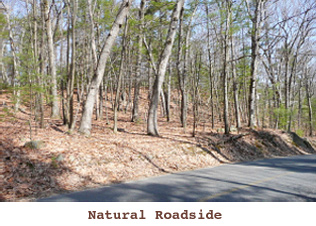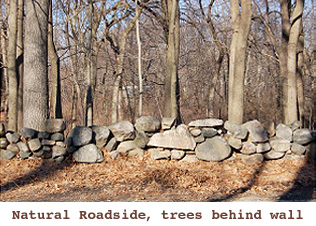Natural Roadside Guidelines
The visual quality of Natural Roadsides depends in part on management of the adjacent woodland. Owners of adjacent land are encouraged to manage the woodlands to foster the growth of selected trees and control invasive species. Planting of new trees within the road right-of-way should be of native species and should be limited to zones where trees can be at least 6 ft. from the roadway edge and not directly under utility wires. See the Planting Guidelines.
Stone walls support and enhance these roadsides when well-maintained or reconstructed consistently with the historic “farm” wall character, wirh loosely laid, dry stones free of mortar. Vines or invasive plants should be removed where present. Trees that have grown within the wall structure may need to be removed to prevent further deterioration of the wall. Pulling large vegetation and small trees by the roots can damage the wall. Large trees should be removed by cutting at the base, and allowing the stump to deteriorate.
Overhead power lines often conflict with the woodlands associated with this roadway type and utility company pruning practices can leave badly disfigured trees. The Town’s communications with the utility companies need to emphasize the requirement for pruning practices that deal with the overall shape of the tree, rather than strictly meeting minimal clearance standards.


![]() To identify your road type, see Roadside Types definitions and Roadsides types map
To identify your road type, see Roadside Types definitions and Roadsides types map
![]() For a complete list of guidelines, see the Lincoln Roadside Report, pp. 18 - 38
For a complete list of guidelines, see the Lincoln Roadside Report, pp. 18 - 38


